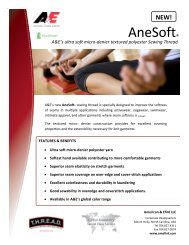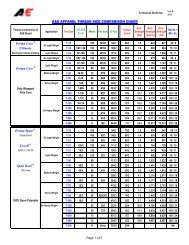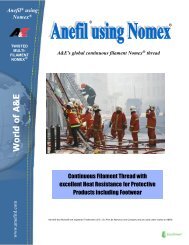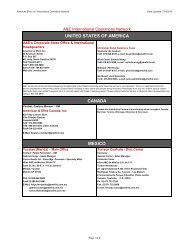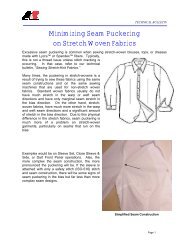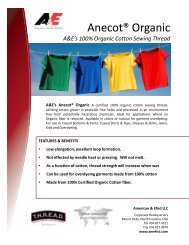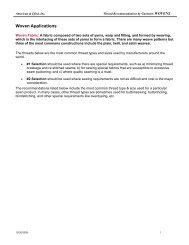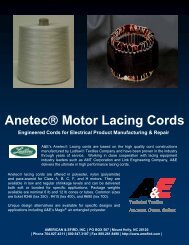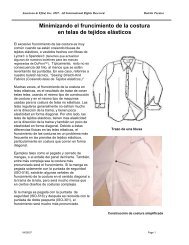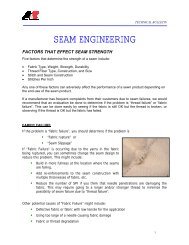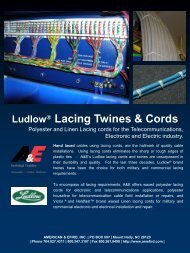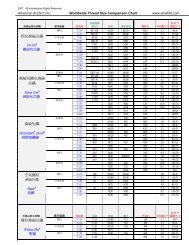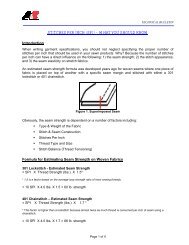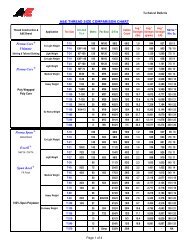Stitch Type Matrix - American & Efird, Inc
Stitch Type Matrix - American & Efird, Inc
Stitch Type Matrix - American & Efird, Inc
Create successful ePaper yourself
Turn your PDF publications into a flip-book with our unique Google optimized e-Paper software.
ISO <strong>Stitch</strong> Terminology AMERICAN & EFIRD, INC Page 1 of 4<br />
<strong>Stitch</strong> Drawing<br />
ISO 4915 Common<br />
Top View As Sewn Bottom View As Sewn Number Application Requirements <strong>Stitch</strong> Description<br />
Single Thread Chainstitch 101 Basting <strong>Stitch</strong> for Specify SPI.<br />
Tailored Clothing;<br />
<strong>Stitch</strong> formed by a needle thread passing through the<br />
material and interlooping with itself on the underside<br />
Bag Closing<br />
of the seam with the assistance of a spreader.<br />
Single Thread Chainstitch or<br />
Lockstitch Buttonsew,<br />
Buttonhole or Bartack<br />
* 304 Lockstitch is<br />
preferred when stitch<br />
security is a Must.<br />
Single Thread Blindstitch No stitch visible on the<br />
Bottom or Outside of Sewn<br />
Product<br />
Lockstitch - Most Common of<br />
All <strong>Stitch</strong>es<br />
101<br />
or<br />
304<br />
103<br />
Buttonsew,<br />
Buttonhole, or<br />
Bartack<br />
Blindstitch<br />
Hemming,<br />
Felling, Making<br />
Belt Loops<br />
Bobbin Thread on Bottom 301 Topstitching,<br />
Single Needle<br />
<strong>Stitch</strong>ing, Straight<br />
<strong>Stitch</strong>ing<br />
Zig Zag Lockstitch 304 Intimate Apparel,<br />
Athletic wear,<br />
Infantwear,<br />
Exercisewear<br />
Chainstitch Looper Thread on Bottom 401 Single Needle<br />
Chainstitch -<br />
Mainseams on<br />
Wovens<br />
Zig Zag Chainstitch Looper Thread on Bottom 404 Zig-Zag<br />
Chainstitch for<br />
Infantwear and<br />
Childrenswear:<br />
Binding,<br />
Topstitching, etc.<br />
1) Buttonsew - specify<br />
stitches per cycle<br />
(Ex. 8,16, 32)<br />
2) BH - specify length<br />
& width (1/2”, etc.)<br />
3) Bartack - specify<br />
length & width of<br />
tack.<br />
Specify<br />
1) SPI 3 - 5 SPI<br />
2) Non-skip or 2 to 1<br />
skipped stitch<br />
Knit Shirts - Buttonhole length generally is 1/2 inch, is<br />
placed horizontally, with approximately 85-90 stitches<br />
<strong>Stitch</strong> is formed with one needle thread that is<br />
interlooped with itself on the top surface of the<br />
material. The thread passes through the top ply and<br />
horizontally through portions of the bottom ply without<br />
completely penetrating it the full depth.<br />
Specify SPI. <strong>Stitch</strong> formed by a needle thread passing through the<br />
material and interlocking with a bobbin thread with the<br />
threads meeting in the center of the seam. <strong>Stitch</strong><br />
looks the same top & bottom.<br />
Specify<br />
1) SPI<br />
2) Throw or width<br />
Zig-Zag (1/8”, 3/16”,<br />
1/4")<br />
<strong>Stitch</strong> is formed with a needle and a bobbin that are<br />
set in the center of the seam and form a symmetrical<br />
zig-zag pattern. Also, used to identify bartacking and<br />
lockstitch buttonsewing and buttonholing.<br />
Specify SPI. <strong>Stitch</strong> formed by 1-needle thread passing through the<br />
material and interlooped with 1-looper thread and<br />
pulled up to the underside of the seam.<br />
Specify<br />
1) SPI<br />
2) Throw or width Zig-<br />
Zag (1/8”)<br />
<strong>Stitch</strong> is formed with a needle and a looper that are<br />
set on the underside of the seam and form a<br />
symmetrical zig-zag pattern.
ISO <strong>Stitch</strong> Terminology AMERICAN & EFIRD, INC Page 2 of 4<br />
<strong>Stitch</strong> Drawing<br />
Top View As Sewn Bottom View As Sewn<br />
ISO 4915<br />
Number<br />
Common<br />
Application Requirements <strong>Stitch</strong> Description<br />
2 Needle Bottom Coverstitch Looper Thread on Bottom 406 Hemming, Specify<br />
Attaching, Elastic, 1) Needle spacing<br />
<strong>Stitch</strong> formed by 2-needle threads passing through the<br />
material and interlooping with 1-looper thread with the<br />
Binding, (1/8”, 3/16”, 1/4") stitch set on the underside of the seam. Looper thread<br />
Coverseaming, 2) SPI<br />
interlooped between needle threads providing seam<br />
Making Belt<br />
Loops<br />
coverage on the bottom side only.<br />
3 Needle Bottom Coverstitch Looper Thread on Bottom 407 Attaching Elastic Specify<br />
to Men's & Boys 1) Needle spacing<br />
<strong>Stitch</strong> formed by 3-needle threads passing through the<br />
material and interlooping with 1-looper thread with the<br />
Knit Underwear (1/4")<br />
stitch set on the underside of the seam. Looper thread<br />
2) SPI<br />
is interlooped between needle threads providing seam<br />
coverage on the bottom side only.<br />
2 Needle Chainstitch with<br />
Cover Thread<br />
Looper Thread on Bottom 408 Attaching Pocket<br />
Facings to Jeans<br />
& Chino Casual<br />
Pants<br />
2 Thread Overedge Single "purl" on Edge 503 Serging &<br />
Blindhemming<br />
3 Thread Overedge Common Overedge <strong>Stitch</strong> 504 Single Needle<br />
Overedge<br />
Seaming<br />
3 Thread Overedge<br />
Double "purl" on Edge 505 Serging with<br />
Double purl on<br />
Edge<br />
Mock Safety <strong>Stitch</strong> 2 Needle Overedge 512<br />
Seaming Stretch<br />
Knits, Wovens<br />
2 Needle 4 Thread Overedge 2 Needle Overedge 514 Seaming Stretch<br />
Knits, Wovens<br />
Specify<br />
1) Width Bite (Ex.<br />
1/8", 3/16", 1/4")<br />
2) SPI.<br />
Specify<br />
1) Width Bite (Ex.<br />
1/8", 3/16", 1/4")<br />
2) SPI.<br />
Specify<br />
1) Width Bite (Ex.<br />
1/8", 3/16", 1/4")<br />
2) SPI.<br />
Specify SPI.<br />
<strong>Stitch</strong> formed by 2-needle threads passing through the<br />
material and interlooping with 2-looper threads with<br />
the stitches set on the underside of the seam. A top<br />
spreader thread is interlaced on the top side of the<br />
seam between the two needle threads.<br />
<strong>Stitch</strong> formed by 1-needle thread and 1-looper thread<br />
with purl on edge of seam for serging or<br />
blindhemming ONLY.<br />
<strong>Stitch</strong> formed with 1-needle thread and 2-looper<br />
threads with the looper threads forming a purl on the<br />
edge of the seam. For overedge seaming and serging.<br />
<strong>Stitch</strong> formed with 1-needle thread and 2-looper<br />
threads with the looper threads forming a double purl<br />
on the edge of the seam for serging ONLY.<br />
<strong>Stitch</strong> formed with 2-needle threads and 2 looper<br />
threads with the looper threads forming a purl on the<br />
edge of the seam. 512 – right needle only enters the<br />
upper looper loop. <strong>Stitch</strong> does NOT chain-off as well<br />
as 514 <strong>Stitch</strong><br />
Specify SPI. <strong>Stitch</strong> formed with 2-needle threads and 2 looper<br />
threads with the looper threads forming a purl on the<br />
edge of the seam. 514 – both needles enter the upper<br />
looper loop. Preferred over 512 <strong>Stitch</strong> because it<br />
chains-off better.
ISO <strong>Stitch</strong> Terminology AMERICAN & EFIRD, INC Page 3 of 4<br />
<strong>Stitch</strong> Drawing<br />
ISO 4915 Common<br />
Top View As Sewn Bottom View As Sewn Number Application Requirements <strong>Stitch</strong> Description<br />
4 Thread Safetystitch 515 Safetystitch Specify<br />
Combination stitch consisting of a single-needle<br />
Seaming Wovens 1) Needle spacing & chainstitch (401) and a 2-thread Overedge stitch (503)<br />
(401+503)<br />
& Knits bite - Ex.: 1/8”- that are formed simultaneously. Uses less thread than<br />
1/8", 3/16”- 3/16"’ a 516 stitch; however, many manufacturers prefer a<br />
3/16” – 1/4"<br />
2) SPI<br />
516 stitch.<br />
5 Thread Safetystitch 516<br />
(401+504)<br />
2 Needle 4 Thread Coverstitch 602<br />
Safety <strong>Stitch</strong> Specify<br />
Seaming Wovens 3) Needle spacing &<br />
& Knits bite - Ex.: 1/8”-<br />
1/8", 3/16”- 3/16"’<br />
3/16” – 1/4"<br />
4) SPI<br />
Binding A Shirts,<br />
Infants Clothing,<br />
etc.<br />
3 Needle 5 Thread Coverstitch 605 Lap Seaming,<br />
Coverseaming,<br />
Binding on Knits<br />
4 Needle 6 Thread Coverstitch Flatseamer/Flatlock 607 Flat or Lap<br />
Seaming Knit<br />
Underwear,<br />
Fleece, etc.<br />
Specify<br />
1) Needle spacing<br />
(Ex: 1/8", 3/16",<br />
1/4")<br />
2) SPI<br />
Specify<br />
1) Needle spacing<br />
(Ex: 1/4")<br />
2) SPI<br />
Combination stitch consisting of a single-needle<br />
chainstitch (401) and a 3-thread Overedge stitch (504)<br />
that are formed simultaneously.<br />
<strong>Stitch</strong> formed with 2-needle threads, a top cover<br />
thread and a bottom looper thread.<br />
<strong>Stitch</strong> formed with 3-needle threads, a top cover<br />
thread and a bottom looper thread.<br />
Specify SPI <strong>Stitch</strong> formed with 4-needle threads, a top cover<br />
thread and a bottom looper thread. Preferred over 606<br />
stitch because machines are easier to maintain.
ISO <strong>Stitch</strong> Terminology AMERICAN & EFIRD, INC Page 4 of 4



